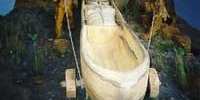Lewis & Clark’s Only Camp
 4:58
Barrett Golding
4:58
Barrett Golding
Digging the Lower Portage camp at Great Falls.
Broadcast: Nov 14 2003 on NPR Living on EarthSeries: Lewis & Clark Trail: 200 Years Later Subjects: Travel, Science, Historical
Lewis & Clark Trail: The Only Camp
November 14, 2003
[VIOLIN PLAYING, CRICKETS TRILLING, WATER SPLASHING]
BRUCE GELLERMAN, host: This year marks the 200th anniversary of the Lewis & Clark expeditions.
MALE: Paddle. C'mon harder.
GELLERMAN: We wondered who lives and works along the trail now, from the northwest coast to mouth of the Missouri.
FEMALE: One, two, three... [DRUM BEATS UNDERNEATH]
[MUSKET SHOT, CRICKETS TRILLING]
GELLERMAN: Producer Barrett Golding bicycled the entire Lewis and Clark Trail and sent us a series of audio postcards.
[VIOLIN PLAYING; CRICKETS TRILLING]
GELLERMAN: Like this one from the Great Falls lower portage campsite near a place in Montana where the Great Plains meet the Rockies. Lewis and Clark made more than 600 camps during their 28 months of travel. But not one had been located – until, after more than a decade of digging – archeologist Ken Karsmizski found enough evidence to positively identify a site along the Missouri River.
[METAL OF SHOVEL SCRAPING DIRT]
KARSMIZSKI: We're at a location that, based on the journals of Lewis and Clark, we're at a campsite that they established on the 16th of June, 1805.
[METAL OF SHOVEL SCRAPING DIRT]
KARSMIZSKI: And what we're looking at is a half-mile stretch of Missouri River, as the crow flies about 10 miles away from Great Falls, Montana. Lewis and Clark were able to see the great falls in 1805, and they had to move around them with probably as much as 30 tons of equipment and 33 guys. It took them a month to do that.
[SOUND OF FLOWING WATER]
KARSMIZSKI: The Lewis and Clark expedition, from the time they left St. Louis, they're out for 863 days. They make over 600 camps. This is the only place where we have enough evidence to say this is it, we have found it. And knowing that this rock right here...
[SOUND OF STRIKING ON ROCK]
KARSMIZSKI: ...and this one...
[STRIKING ON ROCK AGAIN]
KARSMIZSKI: I mean, I'm kneeling down here at the site of a campfire that they knelt at. And even as exciting is that I know that I can walk 50 feet away from here and kneel at another campfire that they built, and then walk 50 feet away from that and kneel at another campfire that they built. And when I started this, the thing that I heard more than anything else – you're not going to find anything. These guys didn't leave anything behind. And my response was, then how did they pick up their fires and take them with them?
[SCRAPING SOUNDS]
KARSMIZSKI: We have found 18 campfires, 15 of those date back thousands of years. But the three fires dating to Lewis and Clark's period are really a key. And then, as we worked around those fires we found some other things. In all, we have over 9,000 pieces of bone that we've collected. Within 15 feet of where we're standing we have essentially a butchering site. And we've radio carbon-dated the bone, and we're coming up with 1810, plus or minus 50. We found a gun flint. We found an iron push pin. Imagine yourself being Clark, and you can see it in the journals, what he's doing is he's completing the maps of the Missouri River. He's sitting out here, he's totally exposed to the wind. He just puts a push pin in each corner of that paper and it holds it down.
[JINGLING OF METAL PIECES]
KARSMIZSKI: They've got a field kitchen. They've got portable desks. They've got push pins to keep their paper down. So everything they think about, and they allow for that. It's an incredible journey. Most people say it's the great American odyssey. This is a group of people who are out in the most forbidding country that they can imagine at their time, with virtually no knowledge. For me, it is really understanding history from a different perspective. And a part of it is also being a part of history.
When Lewis and Clark were on their expedition, and they had gotten as far as Amanden villages, and they were about to set out in the spring of 1805, Lewis took the time to write back to Jefferson, and let Jefferson know what was happening. But he also commented that they were about to set off on the real exploration, and likened himself to Columbus. Lewis likened himself to Columbus. This is a moment in world history that I'm taking a part in, is what Lewis was saying. And I think that's a part of what I feel, in those reflective times, is that this is a part of history that I was lucky enough to take part in. I could fit the pieces together. I could come up with something tangible that has to do with Lewis and Clark. And that's really pretty satisfying.
[SOUND OF WATER FLOWING, BIRDS CHIRPING LOWLY]
GELLERMAN: Ken Karsmizski is director of Oregon's Columbia Gorge Discovery Center. Barrett Golding's "Portraits of the Lewis & Clark Trail: 200 Years Later" are part of the Hearing Voices series, funded in part by the Corporation for Public Broadcasting. For more audio, images and interviews from the trail, go to our website - livingonearth.org.

